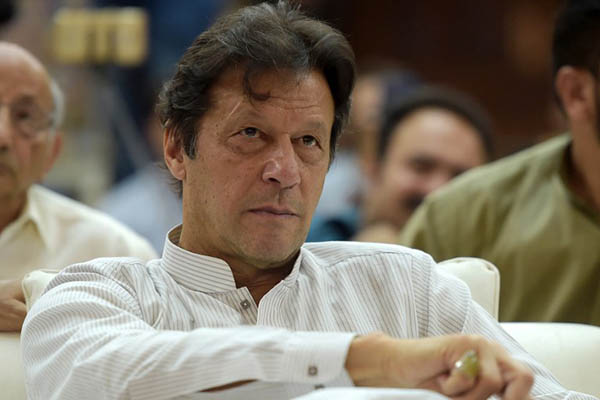
Aamir Qureshi—AFP
The PTI-led government should mark the new year by reaching out to the opposition—and restraining its foul-mouthed lawmakers
Prime Minister Imran Khan, following his election in 2018, was able to mold his ministers in his image. In the provinces and the center, all of them became rough in their discourse and adopted vituperation as their style. The reference was always the past decade and how bad it was when Khan was struggling politically and couldn’t do much to clear the miasma of corruption let loose by the Pakistan Muslim League (Nawaz) government at the center and Pakistan Peoples Party (PPP) in Sindh. His handmaiden National Accountability Bureau (NAB), headed by a man suffering from personality disorder, carried out its mayhem as proof of what the oracle of the Pakistan Tehreek-e-Insaf (PTI) had pronounced.
One year of bad communication was bequeathed to Pakistan while the country needed a lot of cooperation in Parliament to salvage a belly-up economy. Khan carried his worry-beads around—aped less attractively by his Interior Minister Ijaz Shah—as he announced how he would construct hundreds of thousands of houses for Pakistan’s poor, and plant a billion trees to restore the dwindling oxygen-count, and open free kitchens for people going hungry in the cities and—as if in moral compensation—throw his political opponents in jail till they disgorged the big money they had extracted from the state exchequer. The year 2019 was of non-communication and verbal abuse, in which politicians competed and the common man became imitatively debased in character.
Khan appeared adroit in handling a rather wild India under Narendra Modi and his BJP, and joined his Army chief to promote the Kartarpur Corridor. This appeared out-of-character to observers who expected Pakistan to chart its predictable course of empty, anti-India rhetoric that unites Pakistanis but ruins Pakistan’s image internationally. The world meanwhile hates Pakistan’s revisionism vis-à-vis India after nuclearization froze the status quo and points only to normalization. Unlike non-nuclear Bangladesh that endures the Hindutva vagaries on the eastern edge of South Asia and yet has foreign reserves of $30 billion, Pakistan with its $10 billion has succumbed to the challenge of Article 370 of the Constitution annexing India-held Kashmir.
The year 2020 will be martyr to the revisionist nationalism of Pakistani textbooks. There is not much distance between the worry beads of Imran Khan and what is called Ghazwa-e-Hind in Pakistan.
If the world is succumbing to populism, Pakistan has tilted in favor of Khan’s worldview of Islamism, telling the western world how it offends through Islamophobia. Inside Pakistan, non-Muslims are suffering from an opposite phobia that the Muslims of the world have not sorted out. Shockingly, the kidnapping-through-marriage of Hindu girls has not ceased in Sindh while 800 Hindu children have died of starvation in 2019 in Tharparkar, Sindh. Unable to call on India for help, given the strained relations, Pakistan has chosen to ignore the crisis like it has ignored the growing trend across the country of kidnapping and raping small children, a lot of it happening in the madrassas that Khan can’t touch with a bargepole. He’d rather give billions of rupees to keep them off his back as he did when his party was ruling only in Khyber-Pakhtunkhwa. Some of the human rights issues vis-à-vis the non-Muslims of Pakistan can’t be handled because the Islamic Constitution gets in the way. One should be thankful that Khan would not declare them “zimmi” and collect “jiziya” from them.
The other communication problem faced by a bad-mouthing government is in regions where the writ of the state is weak, like Afghanistan, and the populations are alienated. The biggest province Balochistan, where most of the cities are “B” class—meaning there is no normal administration—suffers from “disappearances”; and they run into thousands. Tragically those who speak up about these “disappearances” themselves tend to “disappear” as happened with an honest retired colonel of the Army in Islamabad for his advocacy of the “disappeared” of Balochistan.
Add to the “vacuum” of Balochistan the badlands of the Northern Areas now included in the province of Khyber-Pakhtunkhwa. This is where a 30-year war was fought which changed Pakistan forever. The local population was ignored and allowed to be savaged by the Islamist warriors that Pakistan imported and admired till the infection came down to South Punjab and terrorism was absorbed into the guts of the state. The people of the tribal areas have to be assuaged and their rage endured if Pakistan has to survive. If you include interior Sindh, South Punjab, Balochistan, and the tribal areas, you have almost 60 percent of the territory of Pakistan where the writ of the state is weak. Pakistan’s population has grown to a level where Islamabad can no longer support it. It is increasingly fleeing the weak-writ areas and crowding the already overladen cities.
The PTI government has to do a lot of heavy lifting while keeping its excessively foul mouth shut. It should seek non-traditional relations with India after seeing and digesting that the world, including the Islamic world—barring Turkey and Malaysia—leans in favor of India and thinks Pakistan is economically too fragile and too internally insecure to support. India faces a similar equation with China: it nurses territorial revisionism against it just like Pakistan vis-a-vis India, but trades with it, its two-way volume expected to reach $100 billion this year, thus making China India’s largest trading partner.
Pakistan enjoys great support from “all weather” friend China; unfortunately those ties still aren’t enough to overcome the trade gap when compared to India. The total trade volume between Beijing and Islamabad is $15 billion; $13 billion of that sum is Chinese exports to Pakistan.
